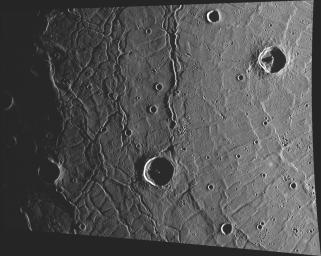This image, taken with the Wide Angle Camera (WAC), shows a portion of the Caloris Basin interior. The linear features visible in the left side of the image, running from top to bottom, are roughly concentric with the basin's rim. A second set of troughs (part of Pantheon Fossae) are radial to a point off the right side of the image. Both sets of troughs formed when the rocks of the basin interior experienced large horizontal forces that caused the surface to undergo faulting (fracturing) and to pull apart.
This image was acquired as part of MDIS's high-incidence-angle base map. The high-incidence-angle base map is a major mapping activity in MESSENGER's extended mission and complements the surface morphology base map of MESSENGER's primary mission that was acquired under generally more moderate incidence angles. High incidence angles, achieved when the Sun is near the horizon, result in long shadows that accentuate the small-scale topography of geologic features. The high-incidence-angle base map is being acquired with an average resolution of 200 meters/pixel.
Date acquired: April 24, 2012
Image Mission Elapsed Time (MET): 243766330
Image ID: 1701461
Instrument: Wide Angle Camera (WAC) of the Mercury Dual Imaging System (MDIS)
WAC filter: 7 (748 nanometers)
Center Latitude: 28.58°
Center Longitude: 152.3° E
Resolution: 296 meters/pixel
Scale: The crater on the right side of the image is abut 40 km (25 mi) in diameter.
Incidence Angle: 86.9°
Emission Angle: 40.4°
Phase Angle: 127.3°
The MESSENGER spacecraft is the first ever to orbit the planet Mercury, and the spacecraft's seven scientific instruments and radio science investigation are unraveling the history and evolution of the Solar System's innermost planet. Visit the Why Mercury? section of this website to learn more about the key science questions that the MESSENGER mission is addressing. During the one-year primary mission, MDIS acquired 88,746 images and extensive other data sets. MESSENGER is now in a year-long extended mission, during which plans call for the acquisition of more than 80,000 additional images to support MESSENGER's science goals.
These images are from MESSENGER, a NASA Discovery mission to conduct the first orbital study of the innermost planet, Mercury. For information regarding the use of images, see the MESSENGER image use policy.

 Planetary Data System
Planetary Data System












